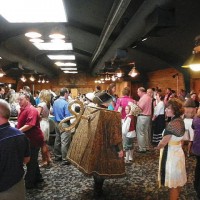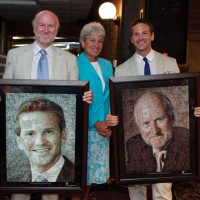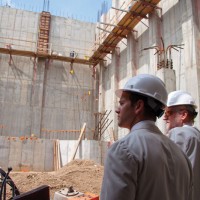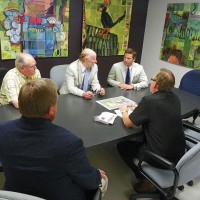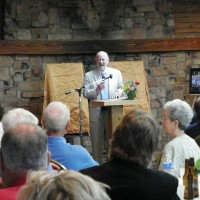News
It All Plays Well Here
Peoria region has the arts and passion; always looking for a bigger audience
Faced with a dilemma a few short years ago, the arts community in the Peoria area did what it had done many times before: It quit relying on others and took action itself.
The Peoria Live Theatre League was born and while it is still growing it is central Illinois' leading — if not its only — place to find out not only what is happening in local community theatre as well as read reviews of the show presented.
It also is now a model for community theatre groups nationwide who, like those in Peoria, found themselves begging for media coverage of their shows. Staff reductions at newspapers across the country, including the Peoria Journal Star, ended most theatre reviews — critiques these groups counted on to put people at the ticket booth and in the seats.
Rocco Landesman, chairman of the National Endowment of the Arts, has applauded the local effort and in fact has told countless other communities about the Peoria Live Theatre League.
But is it enough? People have to know about the league to get much out of it. And the local theatre groups that have little to spend on advertising still must rely on media that will do preview stories about upcoming shows, including thepeorian.com, said Suzette Boulais, executive director of Arts Partners of Central Illinois.
"The Live Theatre League was born out of necessity. When the letters went out from the Journal Star to the different organizations that it was going to stop doing reviews it was devastating. But Arts Partners facilitated a discussion with the different groups and decided to be proactive. It was an answer to a problem and it is dynamic. Now we just have to keep growing and reaching more people," Boulais said.
She could have just as easily been talking about the many other arts that are available in Peoria. Many people involved agree that once the public becomes aware of what there is here, they become true fans.
They also agree that many in the area don't realize what is available in the Peoria region, for children to adults, from visual arts to performance arts.
And for a metropolitan area this size, Peoria offers a lot, Rocco Landesman said in an exclusive interview with The Peorian. "Peoria is very active in the arts. It is a perfect example of how different public and private partnerships can work to promote the arts and the people I have met in my trips to Peoria are incredibly supportive of the arts," he said.
He cited his most recent trip last August, when U.S. Rep. Aaron Schock, R-Peoria, invited him to see progress in the arts community since his previous visit in November 2009. In just a matter of days Schock, Boulais, Kathy Chitwood of Arts Partners and former head of Eastlight Theatre put together a reception and performances by several groups at Wildlife Prairie State Park. Thinking that the audience would be small because of the short notice and because of poor weather that day, Landesman said he was amazed when he saw several hundred people there.
"Peoria has very committed people wanting to use the arts but it is up to them, to the arts organizations themselves to get the word out about what they offer," he said.
He said social media networks such as Facebook and blogs are quick becoming the best friends of the arts community. "Social media give the arts organizations the opportunity to reach an awful lot of people without spending a lot of money on advertising. We're doing it now at the NEA," said Landesman, who writes his own blog that can be found on the NEA website, www.nea.gov. Peoria has been a frequent subject of his blog.
Landesman said studies have shown that people who engage the arts through live media are two to three times more likely to attend events later.
"There is a lot of important art that doesn't find its way into the marketplace for one reason or another," he said, adding the lack of advertising money and marketing savvy are often the chief reason. "It is important to find ways to get those things into the mainstream, into the public eye."
Peoria also has made strides in that regard, said Chitwood, whose challenge to Landesman to come see what this region has to offer shortly after he became head of the NEA led to his November 2009 visit. Landesman had made an unintentionally belittling remark about Peoria theatre and after hearing from Chitwood and others he chose to make Peoria the first stop on his initial arts tour of the country.
He now counts Chitwood and Boulais among his closest friends.
Chitwood said that while it was important Landesman see Peoria theatre, she also wanted him to be aware of the other performing and visual arts here.
"It has always been amazing to me the number of visual artists we have here and the number of studios, including many that are opening now," she said.
She agreed the average Peorians may not realize what is available here. "Everybody gets focused on their own thing and until they get exposed to something new, they don't include it. One of the challenges of the arts has always been to expand their base. You know, everyone has had the arts touch their lives in one way or another during their lives. But they still take a lot of it for granted or don't recognize it as art," Chitwood said.
Boulais said once people become aware of one part of the arts community, the loop keeps growing larger and larger. "It's like in a theatre program. You get it at a show you're attending and inside you will see what else is happening at this theatre or that, a showing at somebody's art studio, a dance recital. You eventually find out how rich our arts community is, but you have to take that first step," she said.
"I'm a firm believer that arts awareness is arts education. That is one of the roles Arts Partners plays in the community, cross promoting to keep the arts in the minds of the public," she added.
William Butler, executive director of the Contemporary Art Center of Peoria, said there seems to be a group of people knowledgeable about visual art who frequent the local art scene. But even numbering 2,000 to 3,000 people, that group is relatively small.
"A lot of people think of art as a form of entertainment they'll do once a year. It's not really an integral part of their lives. Don't get me wrong; I'm glad they do it at least once a year but they can get a more holistic view of what happens in the arts community if they come more frequently. For many it becomes a lifestyle," he said.
Preston Jackson, a partner in the Contemporary Arts Center and arguably Peoria's best known artist, said he believes the local art scene has been undergoing change in recent times but that it has been for the good. "Old traditional art has dropped off and we're seeing new talent coming in. That's a good thing because Peoria needs to stay current," he said.
He and Butler said he also believes Peoria is unique for its size in terms of what its arts community offers. However, they agreed presenting a more compact way of displaying it, particularly the visual arts, would make it easier to promote.
One of the reasons Jackson helped open the Contemporary Arts Center in what had become a dilapidated downtown building was to give the arts community more of a central place. Keeping it along the riverfront was natural, he said. "Now this building is alive. It has value," he said.
The Murray Building just up the street a bit has several studios, as well, devoted to helping artists work their magic on canvas, ceramics, metals, wood or with paints, charcoal or other tools.
But from there the many studios in Peoria are spread out. When the Central Illinois Artists Organization has its First Fridays studios tours the first Friday of every month, a person cannot hit all the venues without driving.
CIAO is growing and so is the number of people visiting the studios each first Friday. But would it grow faster if there was a more specific arts district in Peoria where walking venue to venue would be the norm?
Would it behoove the city to set aside for a dedicated arts district a portion of the Warehouse District as its development continues? Would it further be in the city's interest to somehow gives financial support to that district?
The arts community would certainly welcome it.
"Arts district can make a big difference to a community when cities support the district. It seems to me with what Peoria wants to do with its Warehouse District it would be almost like the poster child for using the arts for helping to revitalize an area," Landesman said.
Said Boulais, "We, of course, would be very pleased if there was something set aside in the Warehouse District for the arts. The city is aware the arts community must stay a vital part of the Warehouse District and there is a lot of space available for our arts community."
Butler believes there is something to be said for being able to stay independent without government help. Those who have invested in their own space in Peoria should be commended, he added.
But for the most part, he added, "Artists can't afford it. But artists do have a willingness to work hard to keep their space nice. It shows their pride. I think our arts community would be enthusiastic about space in the Warehouse District but most couldn't afford to do it on their own. It would be worth it to the whole are, I believe, for the city to invest in its arts community."
Butler said he believes it also would help the visual arts to become more known if the arts community was more compact. "The city has talked about wanting to have a 'pleasant walking experience' downtown. I think Peoria Heights is a place that has more of a sense of it right now. There is an area in St. Louis called The Loop that has it. Somebody there organized it and it has been a huge success. Organization is what it takes," he said.
It also takes a little different mindset, those involved agreed. "We really have to treat it like a business. If we're going to do it right we have to make it worthwhile for those involved, including investors," Butler said.
Chitwood said she believes the local business community would be more willing to invest in the arts if it saw there was a lot of public support, if the people who frequent those businesses were people apt to frequent the art scene. "You have to think like a business person when you are trying to sell the arts. Until we can show them the numbers they want to see, we won't get government entities and business to come around.
"Bigger is better in this case; a chorus is a heckuva lot louder than a soloist," she said.

